
U.S. Geological
Survey Fact Sheet 022-00
Online version 1.0
|
Volcano Hazards of the Lassen Volcanic National Park Area, California |
|
ABSTRACT In May 1915, Lassen Peak, California, the southernmost active volcano in the Cascade Range, erupted explosively. Avalanches, mudflows, and flows of hot ash and gas devastated nearby areas, and volcanic ash fell as far away as 200 miles to the east. The Lassen area remains volcanically active, and the volcano hazards demonstrated in 1915 still can threaten not only nearby areas but also more distant communities. Recent work by scientists with the U.S. Geological Survey (USGS) in cooperation with the National Park Service is shedding new light on these hazards. |
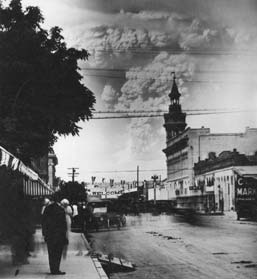 |
The
May 22, 1915, explosive eruption of Lassen Peak, California, blasted pumice
and rock fragments high into the air. In this photograph taken from the
town of Red Bluff, 40 miles west of the volcano, a huge column of volcanic
ash and gas produced by the eruption rises to a height of more than 30,000 feet. Winds blew volcanic ash eastward from the column, raining fine ash at least as far away as Winnemucca, Nevada, 200 miles from the volcano. The ash cloud from a similar eruption today would pose a serious hazard to flying aircraft in the Western United States. (Photo by R.E. Stinson; courtesy National Park Service.) |
On the night of May 19,
1915, the few people homesteading outside of Old Station along Hat Creek near
the foot of Lassen Peak, a volcano in northern California, went to bed expecting
a peaceful night’s sleep. By now they had become accustomed to the sounds
of small steam explosions coming from the volcano, which had been intermittently
active during the past year. Around midnight, Elmer Sorahan was awakened by
his dog barking furiously and pawing him. Dressing quickly, Elmer went outside,
expecting a bear or other animal. Instead, he dimly saw a 12-foot-high wall
of muddy water and logs rumbling down Hat Creek. After running more than a mile
to warn his downstream neighbors, the Halls, he burst through their front door
exhausted and shouting “Get out! get out! there’s a flood coming.”
Mrs. Hall quickly spread the alarm downstream by telephone, and then the family
scrambled uphill just before the house was swept off its foundation.
The next morning residents
of the area saw that a wide swath of the northeast slope of Lassen Peak had
been devastated by a huge avalanche and mudflow triggered by a powerful explosion
at the volcano’s summit. Fortunately, because of the warnings, no one was
killed, but several houses along the creek were destroyed. When Lassen Peak
erupted again on May 22nd, the area was further devastated by a high-speed flow
of hot volcanic ash and gas (called a “pyroclastic flow”), and the
incorporation of snow into this flow generated new mudflows. Ash from the eruption
rose high into the air and wind blew it eastward. Fine ash fell at least as
far as 200 miles from the volcano. Because of the eruptive activity, which continued
through 1917, and the area’s stark volcanic beauty, Lassen Peak and the
area surrounding it were declared a National Park in 1916.
The Lassen region has been volcanically active for about 3 million years. Lassen Peak and nearby volcanic domes are the most recently active parts of the Lassen “volcanic center,” which began to erupt about 600,000 years ago. From 600,000 to 400,000 years ago, eruptions built a large conical volcano, often referred to as “Brokeoff Volcano” or “Mount Tehama,” which was roughly the size of Mount St. Helens, Washington. Later, this volcano became inactive and was mostly eroded away, leaving remnants that include Brokeoff Mountain, Mount Conard, Mount Diller, and Diamond Peak.
Subsequent eruptions from the Lassen volcanic center have formed more than 30 steep-sided, mound-shaped accumulations of volcanic rock, called “lava domes.” Eruptions about 27,000 years ago formed Lassen Peak, one of the largest lava domes on Earth. When Lassen Peak formed, it looked much like the nearby 1,100-year-old Chaos Crags domes, with steep sides covered by angular rock talus. However, from 25,000 to 18,000 years ago, during the last ice age, Lassen Peak’s shape was significantly altered by glacial erosion.
Lassen Peak and its neighboring lava domes are not typical, conical “stratovolcanoes” like Mount Shasta or Mount Rainier. Those large volcanoes were formed by repeated eruptions of lava and ash from a central summit vent over tens of thousands of years. The Lassen dome field, in contrast, is an example of a volcanic area that erupts lava from numerous individual vents, each of which is active for a few years to a few decades and usually does not erupt again.
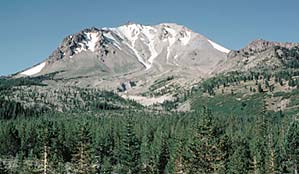 |
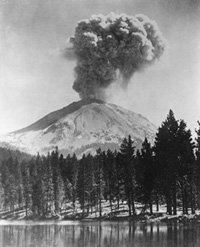 |
| The northeast side of Lassen Peak still shows the scars of its 1914 to 1917 series of eruptions. The strongest of these eruptions in May 1915 destroyed a 3-square-mile area, now called the Devastated Area. Photo at right shows the peak in eruption in October 1915 (photo by Chester Mullen; courtesy National Park Service). | |
The composition of the molten
rock (magma) that feeds volcanism in the Lassen area ranges widely in its content
of silica (SiO2). When high-silica (dacite) magma rises to the Earth’s
surface, it can erupt explosively to produce ash clouds and pyroclastic flows.
Dacite magma extruded nonexplosively forms lava domes, because it is too viscous
to flow far away from its source. Low-silica (basalt) magma is more fluid and
usually erupts less explosively than dacite magma. Eruptions of basalt magma
typically produce elongate lava flows, as well as build cinder cones (piles
of small frothy lava fragments or “cinders”) around volcanic vents.
In the past 50,000 years, at least seven major episodes of dacitic volcanism produced lava domes and pyroclastic deposits in the Lassen area, and another five episodes produced basaltic and andesitic (silica content between basalt and dacite) lava flows. In addition, about 30 smaller volcanoes erupted basaltic lavas in the larger region surrounding the Lassen volcanic center.
The most common volcanic
activity in the Lassen Peak region consists of small to moderate-sized eruptions
that produce basaltic lava flows and localized ash falls. These eruptions typically
last a few months to a year, but may continue for several years. They can cover
more than a square mile with lava flows, build cinder cones as high as 1,000
feet, and blanket many square miles with ash a few inches to several feet deep.
Because these eruptions are relatively nonviolent, they rarely cause human fatalities.
 |
 |
| This twisted stump is all that remains of a 100-foot-tall red fir tree snapped off in Lassen Peak’s May 1915 eruptions. During the eruptions, high-speed avalanches of hot ash, rock fragments, and gas (pyroclastic flows) and huge mudflows of volcanic materials and melted snow (lahars) swept down the northeast flank of the volcano, flattening many acres of mature forest (see photo on left by Benjamin Loomis; courtesy National Park Service). Some of the lahars traveled more than 12 miles from the volcano, destroying homes along Hat Creek. | |
Basaltic volcanism in the
Lassen area occurs mainly along chains of vents aligned in a northor northwest
direction, parallel to regional faults. Examples include Poison Buttes, Subglacial
Buttes, Tumble Buttes, the Prospect Peak-Red Cinder area, the east side of the
Hat Creek Valley and Potato Buttes-Sugarloaf area, and the Red Lake Mountain
area. Prolonged basaltic volcanism at a single site can produce a sizeable edifice,
like the broad, relatively flat “shield” volcanoes of Prospect Peak
and
Sifford Mountain.
Dacite eruptions in the
Lassen area typically begin with steam explosions caused by the interaction
of rising magma with ground water.When dacite magma charged with volcanic gases
reaches the surface, it erupts explosively, usually as a vertical column of
gas and ash that can rise several miles into the atmosphere. Heavy fallback
of hot ash and rock fragments from eruption columns may generate highly mobile
pyroclastic flows that can rush several miles down a volcano’s slopes and
adjacent valleys. Fallout from the eruption column can blanket areas within
a few miles of the vent with a thick layer of pumice, and high-altitude winds
may carry finer ash tens to hundreds of miles from the volcano, posing a hazard
to flying aircraft, particularly those with jet engines.
After an initial explosive eruption, extrusion of gas-depleted dacite magma commonly forms lava domes. Growing lava domes are inherently unstable, and collapse of their steep sides often generates pyroclastic flows of lava blocks and ash that can travel several miles. Such a sequence of events is recorded by the deposits related to the emplacement of Chaos Crags domes between 1,100 and 1,000 years ago.
Interaction of hot pyroclastic flows with snow and ice can generate highly mobile flows of mud and debris (called “lahars”) that may rush down valleys leading away from a volcano. Because of this, active volcanoes that have a significant snow and ice cover can be particularly dangerous. The lahars that threatened residents of the Lassen area in May 1915 were generated by relatively small eruptions of Lassen Peak. Nonetheless, they traveled down creek beds as far as 12 miles and released floods that affected valleys for 30 miles downstream.
Additional volcano hazards at Lassen are rockfalls and landslides not directly related to eruptions. Recently erupted volcanic domes are unstable and can collapse, generating small to large rockfalls. Approximately 350 years ago, collapse of one of the Chaos Crags domes generated huge rockfalls, creating an area now called the Chaos Jumbles. The first and largest of these traveled 4 miles downslope and was able to climb 400 feet up the side of Table Mountain. The trigger for the rockfall is unknown, but it was most likely a large earthquake. Normal weathering also weakens fractured volcanic rock and contributes to small rockfalls. In the summer of 1994, a rockfall of 13,000 cubic yards (the volume of about 500 minivans) occurred on thenortheastern flank of Lassen Peak. During periods of extreme rainfall or snow melt, mudflows are sometimes generated by mobilization of loose volcanic debris and soil on the slopes of volcanoes.
 |
 |
| The Chaos Crags, a group of six lava domes, was formed about 1,100 years ago in the latest large eruptions to occur in the area of Lassen Volcanic National Park. The large block of lava in the photo on the right was carried down from the Crags in a high-speed avalanche of hot rock fragments and gas (pyroclastic flow) generated when the unstable edge of one of the growing lava domes collapsed. The radial joint pattern was formed as the block cooled. | |
Volcano hazards are generally evaluated on the basis of an area’s record of eruptions over the past 10,000 years, because future eruptions are most likely to occur near areas that have most recently had volcanic activity. However, in the Lassen region eruptions occur infrequently, so the record of activity in the past 50,000 years was used to provide an adequate basis for defining hazard zones. During this period, eruptions in the Lassen region have occurred at sites including Lassen Peak, Chaos Crags, and Sunflower Flat (explosive dacite eruptions followed by dome growth) and Tumble Buttes, Hat Mountain, and Prospect Peak (basalt eruptions). The areas of highest hazard are those that could be affected by pyroclastic flows and mudflows (see map). These areas, including Hat Creek Valley, are those in the immediate vicinity and downhill from likely eruption sites. Fallout of ash will affect areas downwind at the time of an eruption. Within the hazard zones, relative hazard is gradational, decreasing away from the location of potential vents.
Because geologically recent
volcanic activity in an area is the best guide to forecasting future eruptions,
scientists study the lava flows, ash, and other deposits from past eruptions.
Volcanoes in the Lassen area tend to erupt infrequently, and may be inactive
for periods lasting centuries or even millennia. The most recent eruptions in
the Lassen area were the relatively small events that occurred at Lassen Peak
between 1914 and 1917. The most recent large eruption produced Chaos Crags about
1,100 years ago. Such large eruptions in the Lassen area have an average recurrence
interval of about 10,000 years. However, the geologic history of the Lassen
area indicates that volcanism there is episodic, having periods of relatively
frequent eruptions separated by long quiet intervals. For example, the last
large event before the Chaos Crags eruption was the one that built Lassen Peak
27,000 years ago.
 |
VOLCANIC SITES IN THE LASSEN REGION AND ERUPTIONS IN THE PAST 50,000 YEARS The Lassen
region has been volcanically active for more than 3 million years. The
Lassen “volcanic center” began to erupt about 600,000 years
ago. From 600,000 to 400,000 years ago, eruptions built a large volcano,
often referred to as “Brokeoff Volcano” or “Mount Tehama”
(outlined by brown circle). Later, this volcano became inactive and was
mostly eroded away, leaving remnants that include Brokeoff Mountain, Mount
Conard, Mount Diller, and Diamond Peak. Subsequent eruptions in the Lassen
volcanic center have formed more |
|
 |
 |
|
The most important sign of an impending volcanic eruption is seismic activity beneath the volcanic area. Seismologists can interpret subtle differences between earthquakes related to the rise of magma and the more familiar quakes caused by tectonic faulting. Other warning signs of magma rising into the shallow subsurface might include increased release of volcanic gases from small openings called fumaroles, such as those found in the Bumpass Hell area of Lassen Volcanic National Park, and changes in the gas composition. Deformation of the ground surface in the vicinity of a volcano may also indicate that magma is approaching the surface. Typically, these warning signs appear a few weeks to months before an eruption, but can last for decades or even centuries without leading to an eruption.
|
VOLCANO
HAZARD ZONES OF THE LASSEN VOLCANIC NATIONAL PARK REGION
|
|
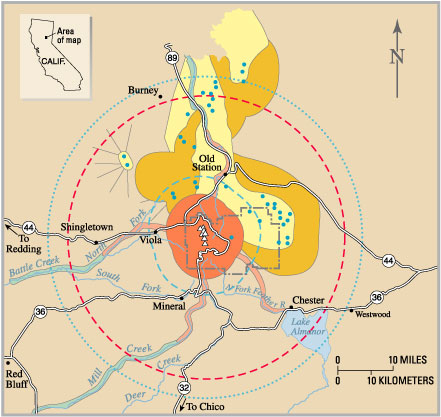 |
 |
| The areas of highest hazard in the region of Lassen Volcanic National Park are those that could potentially be affected by pyroclastic flows and mudflows. These areas are those in the immediate vicinity and downhill from likely eruption sites. Fallout of ash will affect areas downwind at the time of an eruption. Within the hazard zones, relative hazard is gradational, decreasing away from the location of potential vents. | |
After the eruption of Mount St. Helens in 1980, the U.S. Geological Survey (USGS) intensified its monitoring of active and potentially active volcanoes in the Cascade Range. Monitoring of the Lassen area includes periodic measurements of ground deformation and volcanic-gas emissions and continuous transmission of data from a local network of nine seismometers to USGS offices in Menlo Park, California. Should indications of a significant increase in volcanic activity be detected, the USGS will immediately deploy scientists and specially designed portable monitoring instruments to evaluate the threat. In addition, the National Park Service (NPS) has developed an emergency response plan that would be activated to protect the public in the event of an impending eruption.
|
ASH
FALL FROM ERUPTIONS IN THE LASSEN REGION 600,000 YEARS AGO
|
|
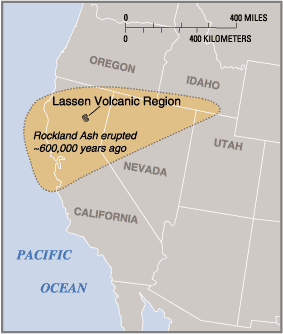 |
Although extremely unlikely today, very large eruptions have occurred in the Lassen region in the distant past. For example, about 600,000 years ago there was an eruption 50 times larger than the 1980 eruption of Mount St. Helens. Because some winds at the time of that eruption were blowing southward, ash several inches thick was deposited as far south as the San Francisco Bay area. Ash particles from this deposit, known as the Rockland Ash, are shown in the photo below, magnified about 70 times. A similar eruption today could affect communities anywhere in northern California and northwestern Nevada, depending on wind direction. Even a light dusting of volcanic ash can close roads and seriously disrupt communications and utilities during and for many weeks after an eruption. |
 |
|
Recent work by scientists with the USGS in cooperation with the NPS is shedding new light on volcano hazards in the Lassen Volcanic National Park area. The work of these USGS scientists is only part of the USGS Volcano Hazards Program’s ongoing efforts to protect people’s lives and property in all of the volcanic regions of the United States, including the Pacific Northwest, eastern California, Wyoming, Alaska, and Hawaii.
Michael A. Clynne, Robert L. Christiansen, C. Dan Miller, Peter H. Stauffer, and James W. Hendley II
For more
information or copies of the paper version of this fact sheet contact:
U.S. Geological Survey
David A. Johnston Cascades Volcano Observatory
5400 MacArthur Blvd.
Vancouver, WA 98661
Telephone (360) 993-8900
Fax (360) 993-8980
COOPERATING
ORGANIZATIONS
Lassen Park Foundation
National Park Service
U.S. Forest Service
Related
Fact Sheets
What
are Volcano Hazards? (USGS Fact Sheet 002-97)
Eruptions
of Lassen Peak, California, 1914 to 1917 (USGS Fact Sheet 173-98)
How Old is "Cinder Cone"?—Solving a Mystery in Lassen Volcanic National Park, California (USGS Fact Sheet 023-00)
See a list of other
volcano-related fact sheets published by the U.S. Geological Survey
PDF version of this fact sheet (3.9 MB)
Download a free copy of Adobe Acrobat Reader
U.S. GEOLOGICAL SURVEY–REDUCING THE RISK FROM VOLCANO HAZARDS
Learn more about volcanoes
and the hazards they pose at the USGS Volcano
Hazards Program website or the Cascades
Volcano Observatory website
For questions about the content of this fact sheet, contact Michael Clynne
URL of this page:
https://pubs.usgs.gov/fs/2000/fs022-00/
Maintained by: Michael Diggles
Created: February 22, 2001
Last modified: May 24, 2005 (mfd)